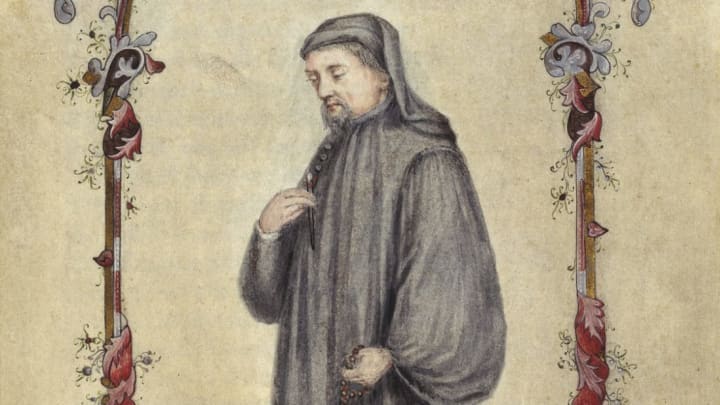Poets all over the world have a lot to thank Geoffrey Chaucer for—after all, the 14th-century English bard gave them the iambic pentameter. The “father of English literature” has written many texts, but none loom as large as The Canterbury Tales.
In the famous epic poem, which dates back to 1387, a group of around 30 pilgrims, including Chaucer, are traveling from the Tabard Inn in Southwark to St Thomas Becket’s Shrine in Canterbury. To while away the time on the road, the innkeeper suggests that everyone tells two stories on the way to the shrine and two on their way back. The best storyteller gets a free supper. Chaucer illustrates characters of different classes in medieval England, so the stories are rude, vulgar, moral, and funny, depending on who’s telling them.
1. Chaucer did much more than just write The Canterbury Tales.
Chaucer was born to a wine merchant somewhere between 1340 and 1345 in London. He led an eventful life: He was a page to Elizabeth de Burgh, countess of Ulster; was captured and ransomed by the French in 1359; was a diplomat sent to Europe on various missions; worked as a customs officer at Wool Quay in London (wool export was a major contributor to the economy in the 14th century); and oversaw the construction of royal buildings.
Amid all these duties, Chaucer wrote in whatever spare time he had. His other works include The Book of the Duchess, written for his patron John of Gaunt praising his deceased wife; the tragic story of Troilus and Criseyde; and dream-vision poem The House of Fame. In his later years, he devoted himself to The Canterbury Tales.
2. The Canterbury Tales is still incomplete.
The Canterbury Tales is a collection of 24 stories, but Chaucer had planned more than 100. He started writing in 1387 and continued working on it until his death in 1400. Though the epic poem has more than 17,000 lines, it was meant to be longer. Some pilgrims introduced in the General Prologue don’t end up telling a tale. The party doesn’t get to Canterbury and their return, therefore, is also missing.
3. Chaucer’s decision to write The Canterbury Tales in Middle English was significant.
When Chaucer penned his magnum opus, most of England’s elite spoke French, thanks to the Norman invasion. His decision to write The Canterbury Tales in Middle English—the language of the common folk—cemented his literary legacy. The epic is regarded as one of the first major works of English literature.
4. There’s a free app that recites The Canterbury Tales in Middle English.
To offer people the authentic Chaucer experience, a team of researchers at the University of Saskatchewan devised an ingenious, 21st-century tool: an app that recites the poem in Middle English. It’s not an easy text to understand, so the app also features a line-by-line modern translation. The 45-minute General Prologue is taken from the Hengwrt Manuscript, written by Adam Pinkhurst (Chaucer’s London associate) at the end of the 14th-century.
Listen to the desktop version here.
5. One of the most important manuscripts of The Canterbury Tales is housed in The Huntington Library in California.
Just 92 manuscripts of the poem have survived, and none are from Chaucer’s lifetime. The order of the tales varies depending on the manuscript, leaving those who have attempted to edit the poem befuddled and wondering what Chaucer originally wanted.
One of the most important versions of The Canterbury Tales is the 15th-century Ellesmere Manuscript. It’s a beautiful piece of work, with illustrations by three artists. There are 22 images of the characters in the manuscript, and a rare portrait of Chaucer. The manuscript is owned by the Huntington Library in San Marino, California.
6. Heath Ledger’s A Knight’s Tale was loosely based on a story in The Canterbury Tales.
Shakespeare’s play The Two Noble Kinsmen was based on "The Knight’s Tale," the first story in Chaucer’s epic. The medieval poet has influenced many, and his tales have been adapted into films and movies, including a modern-day series by the BBC.
In fact, Chaucer was a character in the 2001 medieval action movie, A Knight’s Tale. Heath Ledger played William Thatcher, a peasant trying to change his fate by participating in jousting competitions meant only for knights. Paul Bettany offers comic relief with his role of penniless poet Geoffrey Chaucer, and refers to his work, The Book of the Duchess, in the movie. One of the last scenes is Bettany professing, “I think I’m gonna have to write some of this story down.”
7. The Canterbury Tales inspired a social justice movement in the UK.
Refugees Tales is a project that draws attention to, and challenges, the policy of indefinite detention of refugees and asylum seekers in the UK. The project is organized by poet David Herd, a professor at the University of Kent, and the Gatwick Detainees Welfare Group.
Taking cues from Chaucer’s poem, the project has organized walks every year in the English countryside since 2015. (In 2020, the event went online due to COVID-19.) The program on these walks of solidarity includes readings, performances, and music, and invites walkers to reflect on the immigration crisis. Writers and poets collaborate with detainees and asylum seekers who have suffered indefinite detention, and share their stories anonymously. The tales of these 21st-century pilgrims are also recounted in the three books.
